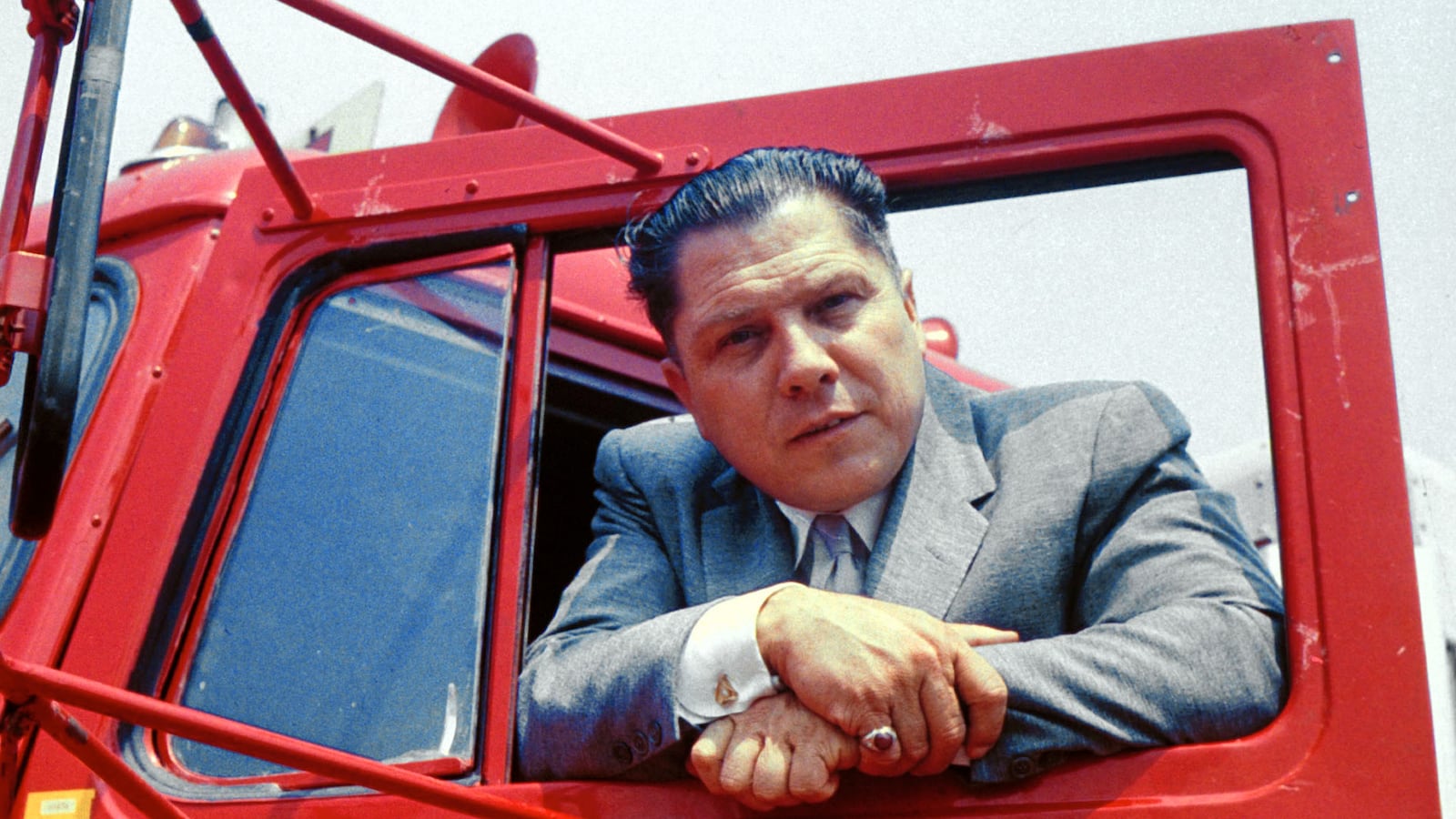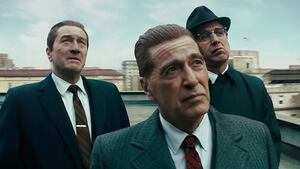Martin Scorsese must be running out of gangster tales. He assembled a star-laden cast and a massive production budget for The Irishman, a dubious “true story” film about the 1975 disappearance of notorious Teamsters leader James R. Hoffa. Even the logline for the movie hedges: “A mob hitman recalls his possible involvement with the slaying of Jimmy Hoffa.”
Wait a minute. A self-professed killer recalls his possible involvement in one of the 20th century’s most famous missing person cases? What does “possible” mean? It tells us the marketing people behind this movie know it’s a shaky story line.
The film industry has a long record of fabricating historical “facts” to make money from movies promoted as “based on a true story.” As a result, vast numbers of movie-going Americans have been badly misinformed about many historical events.
The Irishman refers to the late Frank Sheeran (Robert De Niro in the film), a tough, ex-truck driver with an admitted drinking problem who was, for a time, a local president in the Teamsters Union, a close friend of Hoffa’s and an associate of convicted Mafia figures. Author Charles Brandt did a series of interviews with Sheeran beginning in 1991 through 2003. As he was dying of cancer, Sheeran confided to Brandt that he, Sheeran, killed Jimmy Hoffa (played by Al Pacino) with two bullets in the back of his head in a house in northwest Detroit. Sheeran claimed he killed Hoffa on orders from an East Coast Mafia boss. Brandt wrote a book, I Heard You Paint Houses, about Sheeran and the Hoffa case. Paint houses refers to blood splattering on walls when someone is shot at close range indoors. The Michigan State Police investigated. Hoffa’s blood was not found in the house Sheeran talked about.
Scorsese’s film is based on the book. Those who know the details of the Hoffa case can only wonder why Scorsese would invest so much in this questionable story.
One expert on the case warned star Robert De Niro, in a face-to-face meeting, not to make the movie because Sheeran’s claim that he killed Hoffa was untrue. Dan Moldea is an investigative reporter who has pursued the Hoffa mystery for years. He is the author of The Hoffa Wars.
Moldea has a photo of himself with De Niro at a December 2014 authors’ dinner in Washington, D.C., which he hosted. Through a mutual friend Moldea knew that De Niro was actively involved in negotiations for the film rights to the Sheeran story as the final answer to the Hoffa mystery. Moldea tried to warn him away from the tale.
“De Niro couldn’t have been nicer," Moldea recalls. "Terrific guy. (But) I was very aggressive. I knew I had a finite period of time with this guy. I had to get to the point."
Moldea says he was quite blunt.
“I told him, ‘Bob, you’re being conned.’ I told him in no uncertain terms, ‘Bob, you are being conned.’”
De Niro took offense at the warning and the conversation turned hostile, according to Moldea. “I talked to him the way he talks to people in the movies,” Moldea said.
Moldea was right. The Irishman is not a true story. It doesn’t comport with what is known about the Hoffa case—which is a lot more than you might think, given his infamously unknown whereabouts.
Hoffa was born in 1913 in Indiana and became active in labor union activity as a young man.
In 1957 he was elected president of the International Brotherhood of Teamsters, headquartered in Detroit, which grew and became perhaps the most powerful labor union in the country, controlling virtually all commercial trucking. During his reign, Hoffa was known to consort with major Mafia figures, who had corrupted labor unions in big cities.
In Washington, D.C., Hoffa butted heads with then-Senator Robert Kennedy during Senate labor racketeering hearings. Later as attorney general, Kennedy formed a “Get Hoffa” squad. Hoffa was not the kind of man to back down from Kennedy, or anyone else. Nevertheless, Kennedy got Hoffa.
Convicted in 1964 of attempting to bribe a grand juror, he was sentenced to eight years. Another conviction followed later that year for pension fund fraud. Hoffa went to prison in 1967.
A former close Hoffa associate, the pliable Frank Fitzsimmons, now deceased, took control of the union and let Mafia racketeers use the Teamsters’ massive pension fund as a giant piggy bank.
In 1971, President Richard Nixon granted Hoffa a presidential pardon with a hitch: Hoffa had to stay out of union politics until 1980. Hoffa believed the ban was a fix. He saw it as Nixon’s gift to Fitzsimmons in exchange for the Teamsters’ endorsement of Nixon’s 1972 re-election.
Hoffa was behind bars with a powerful New Jersey mobster and Teamster named Anthony “Tony Pro” Provenzano. It’s widely believed the two had a bitter falling out over Provenzano’s union pension.
By 1975 both men were out of prison but the dark feud between them apparently continued. Hoffa vowed he would regain the presidency of the union. There was widespread street talk that dangerous and powerful organized crime figures, associates of Provenzano, didn’t want Hoffa to lead the union again. Under Fitzsimmons they were bleeding the union pension fund. That might end under Hoffa. He had to be stopped.
In the summer of 1975 Hoffa disappeared and has not been seen since.
I broke the story of the Hoffa disappearance on July 30, 1975. I was a crime beat reporter for WXYZ-TV, the ABC affiliate in Detroit. I was about to end my reporting shift that day when I received an urgent call from a crusty and usually tight-lipped lieutenant in the Michigan State Police Organized Crime section. He gave me a career-changing tip. He said Hoffa was missing and it looked like a kidnapping. Hoffa was last seen standing in the parking lot of the upscale Machus Red Fox restaurant in Bloomfield Township, a Detroit suburb. His car had been impounded and taken to the police garage. It was the only tip I ever received from that cop, but it was a doozy. I raced to get a voice bulletin on the air, then grabbed a camera crew and sped to the suburban police garage to get footage of the car.
The story exploded. The disappearance made headlines coast to coast.
Media stories about Hoffa’s whereabouts took on a “Where’s Waldo?” quality. Hoffa was buried in the end zone of the old Giants stadium, or in a drum in the Florida Everglades, or beneath the pilings for a new Detroit high-rise office complex. Another tale had Hoffa beneath the pavement of I-75, an important truck traffic artery in Detroit, while another story had him buried in a farm field outside Detroit, or maybe in another drum in a New Jersey landfill.
A few weeks after Hoffa disappeared, the Senate Permanent Subcommittee on Investigations, headed by then-presidential hopeful Henry “Scoop” Jackson, sent investigators to dig up a field a short distance from where Hoffa was last seen. The congressional dig, based on a bogus informant tip, became a circus. The media and the curious descended. People brought their own shovels. Helicopters flew overhead as backhoes directed by Senate investigators and state police detectives dug multiple holes. They found nothing.
It wasn’t an FBI operation. The bureau joined the case belatedly, and only after what was likely a staged ransom call to the Hoffa family. The FBI doesn’t just jump in to cases. There must be indications a federal crime is involved. A kidnapping with a ransom demand—extortion—possibly crossing state lines gives the FBI jurisdiction. Otherwise it would be a local missing person case.
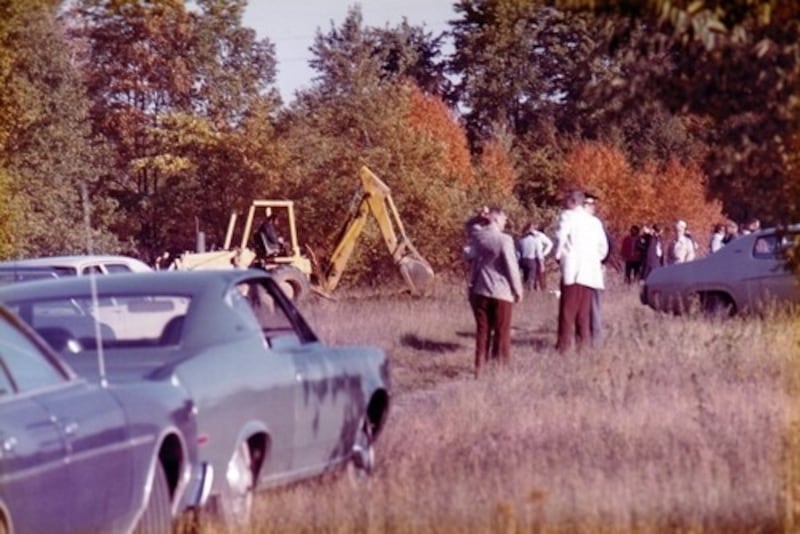
A U.S. Senate subcommittee dug a lot of holes in suburban Detroit, looking for Hoffa’s body. They found nothing.
Courtesy Vince WadeThe late Jay Bailey, the agent in charge of the Detroit FBI office, was reluctant to get involved. For several critical days he held his agents back. FBI Director Clarence Kelly finally ordered Bailey to get on the case.
“We got in on Sunday, four days after,” recalled Robert Garrity, the FBI case agent on the Hoffa disappearance. Hundreds of agents were involved but it was Garrity’s case. I interviewed him in front of the Machus Red Fox restaurant in 1995 for a local TV special on the 20th anniversary of Hoffa’s disappearance.
“We weren't on the scene for some of the criticals, [such as] the search of the car... when you're in there you get a feel for the case right from the beginning,” Garrity said in that interview.
The first problem was the lack of a body. “As you can see in almost any murder case of anybody of notoriety, there’s a lot of clues to be found when you find the body,” Garrity said.
Once the FBI joined the hunt, they learned a lot more even though they didn’t have a body.
Throughout 1975 mob figures had urged Hoffa to attend a peace meeting with Provenzano to clear the air. Hoffa resisted but finally agreed to a meeting. Hoffa told his wife he was going to meet Provenzano on the afternoon he disappeared.
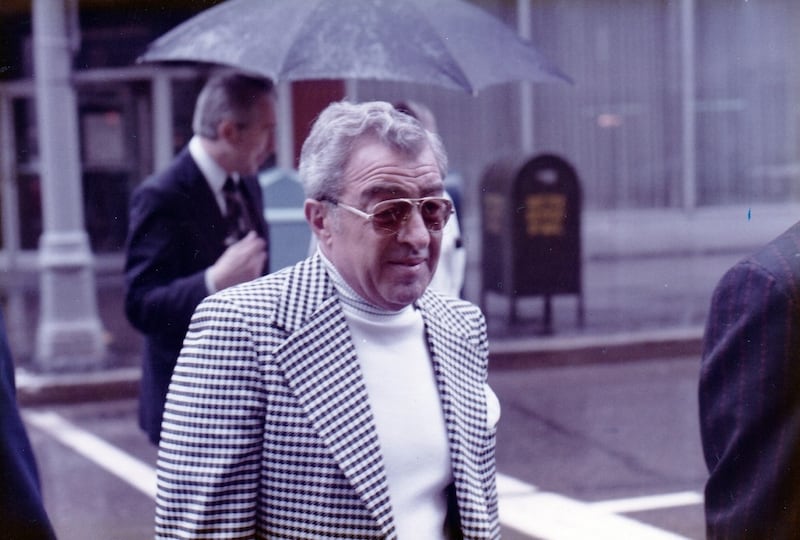
Anthony “Tony Pro” Provenzano, the New Jersey Teamster/Mafioso suspected of organizing the Hoffa hit.
Courtesy Vince WadeThe alleged “peace meet” broker was a local gangster named Anthony “Tony Jack” Giacalone, a feared enforcer in the Detroit Mafia.
Hoffa stood waiting for over an hour in the restaurant parking lot. He was seen by numerous restaurant patrons. His car, a dark green 1974 Pontiac Grand Ville, was found by the local police when Hoffa’s wife reported him missing.
When Hoffa disappeared from the restaurant parking lot, Giacalone was at a nearby athletic club getting a haircut. He made sure people saw him there. Meanwhile, Provenzano was in New Jersey and highly visible to alibi witnesses around the time Hoffa disappeared.
After Hoffa vanished the FBI investigation focused on the activities that day of Charles “Chuckie” O’Brien, Hoffa’s self-described foster son. “We believe Chuckie O’Brien was driving the vehicle,” Garrity said. “That’s been well documented.’
O’Brien couldn’t tell the same story twice about his activities that afternoon. He had been driving the Mercury Marquis of Joey Giacalone, Tony Jack’s son. The FBI seized the car and three trained police dogs found Hoffa’s scent in the trunk. A head hair was later matched with Hoffa’s. O’Brien denied any involvement in the disappearance. Investigators think he was duped in to picking up Hoffa and driving him to his last destination but O’Brien wasn’t part of the actual murder. He never revealed what happened that afternoon.
In November 1975 an important FBI mob informant changed the course of the investigation. Ralph Picardo, an imprisoned racketeer, told agents that trusted associates of Provenzano had abducted and killed Hoffa. One of Provenzano’s henchmen confided details of the crime when he visited Picardo in prison. Prison records showed the Provenzano associate had indeed visited Picardo.
Picardo, now deceased, wasn’t just any snitch. He was a close Teamster associate of Provenzano and two pairs of brothers who were all charged later with violent racketeering activities related to the Teamsters. Court records show Picardo became a trucking company executive at the direction of Provenzano as part of a long-running kickback scheme. Picardo had also served time for murder.
Suddenly, the Detroit grand jury investigation of the Hoffa case came alive and focused on the suspects from New Jersey. Based on Picardo’s information, the FBI suspected Provenzano arranged the hit and turned to a handful of trusted gangsters/Teamsters to do it.
Provenzano likely eliminated Hoffa after getting permission. “I don’t believe he had the authority,” Garrity said. “Someone higher up would have to make (the decision.) If that is true, and I believe it is, they must have perceived him to be a pretty dangerous person to them.”
Who had the juice to order a hit on Hoffa? Federal investigators, East Coast police organized crime squads and veteran crime beat reporters agreed the most likely Mafioso with the authority to approve the abduction and murder of Hoffa was Russell Bufalino (played by Joe Pesci in the film). He was the boss of the Pennsylvania, New Jersey, and upstate New York faction of la Cosa Nostra. He went to prison for conspiring to kill a government witness against him in an extortion trial. Bufalino hated publicity but he had power within the Mafia. Steven Brill, author of a well-researched and highly regarded book The Teamsters, which revolved around the Hoffa disappearance, wrote “Bufalino was the lynchpin of the case.” Bufalino died in 1994.
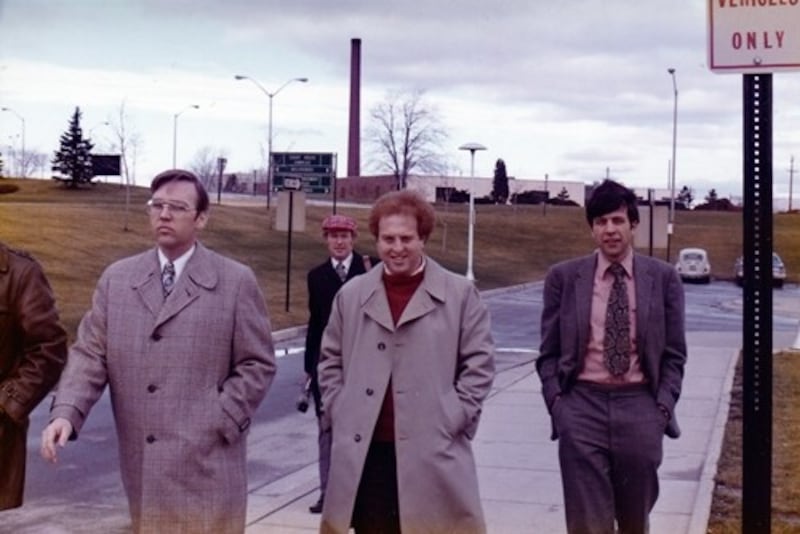
Robert Ozer (deceased), second from right, was the chief prosecutor on the Hoffa case. He said on the record in federal court the government believes the New Jersey suspects are the abductors and killers of Jimmy Hoffa. Frank Sheeran wasn’t included.
Courtesy Vince WadeThe December after Hoffa disappeared, the lead federal prosecutor on the case stated in open court that the government believed three New Jersey men were the likely killers. The late Robert Ozer, head of the Detroit federal Organized Crime Strike Force at the time, told a judge the government had a reliable informant who had named the men. “[He] will identify them as active participants in the abduction and murder of James R. Hoffa,” Ozer said. That government assertion on the record in federal court has never been retracted. Frank Sheeran was not mentioned.
Ozer was in court arguing for authorization for a police line-up featuring the New Jersey suspects for the benefit of two witnesses who claimed they saw Hoffa leaving the restaurant parking lot in a car with several men.
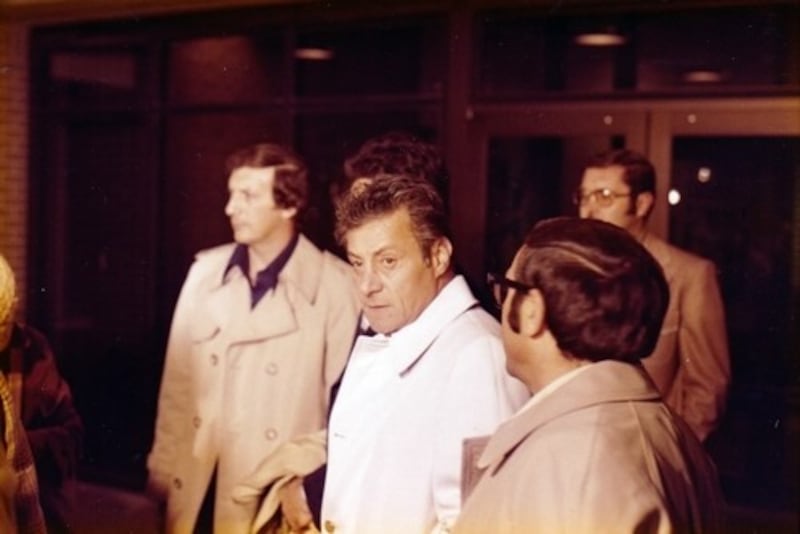
New Jersey Teamsters/mobsters Stephen Andretta, Salvatore Briguglio, and Gabriel Briguglio outside the Oakland County, Michigan, jail after a lineup for two FBI witnesses. Sal (later murdered) is suspected as the actual killer of Jimmy Hoffa.
Courtesy Vince WadeThe men ordered to appear in the line-up were Salvatore (Sal, “Sally Bugs”) Briguglio, his brother Gabriel (Gabe) and Thomas Andretta. All were trusted associates of Provenzano and known to be involved in organized crime. Salvatore Briguglio was believed to be the actual killer, based on Picardo’s information. Provenzano and Briguglio were under indictment for the murder of Anthony “Three Fingers” Castellito, an officer in Provenzano’s Teamster local. Provenzano, Andretta and the Briguglio brothers refused to talk with reporters. They claimed their Fifth Amendment rights when questioned before a federal grand jury.
The Hoffa case line-up occurred but it was inconclusive. Sheeran was not in it.
“We interviewed Mr. Sheeran several times,” Garrity said. “He’s an interesting guy. He [was] close to organized crime people and he was one of the best friends of Mr. Hoffa.”
Garrity said telephone toll records showed Hoffa called Sheeran for something the day before he disappeared.
“Was he there that day? I have no indication he was there,” Garrity said.
It’s important to remember that unequivocal statement comes from the FBI Hoffa case agent, the investigator who read all of the witness and suspect interviews, wiretap transcripts, grand jury testimony, intelligence reports from informants and lab work related to the disappearance of Hoffa.
Those putting stock in Sheeran’s dying confession need to remember what Garrity said and the fact Sheeran was never named in the federal investigation as Hoffa’s killer.
In several places, the Sheeran book shows a lack of due diligence.
Sheeran described himself as the go-to hitman for Mafia bosses who somehow preferred him to “made” Sicilian thugs in their own “families.” Sheeran claimed he even killed people for Hoffa himself. Yet Sheeran’s tale contains glaring errors that Brandt—a trial lawyer—could have easily fact-checked.
The big, burly Teamster claims he flew in a private plane to the Pontiac, Michigan airport north of Detroit. “It’s gone now,” Sheeran said. “If I’m not mistaken it’s a housing development.”
He is mistaken. The Pontiac municipal airport has been in continuous operation since 1928. It’s now called Pontiac International Airport.
Sheeran said he got in a car with the keys in it that had been left in the airport parking lot for him and drove to a house in northwest Detroit. Along the way Sheeran said he passed the Machus Red Fox restaurant where Hoffa was waiting. He didn’t worry that Hoffa might see him because “the restaurant was set back quite a way in the parking lot.”
No, it wasn’t. The standalone restaurant building is only separated from busy Telegraph Road by a sidewalk and one row of parking spaces. If Brandt had done a simple Google satellite map search of the location, he would have known his self-styled hitman was wrong.
Sheeran claims New Jersey Teamster/gangster Salvatore “Sally Bugs” Briguglio was in the Detroit house when he got there. Sheeran said Briguglio had “coke-bottle glasses. He had thick, curly black hair.”
No, he didn’t. He had thick hair but it was sandy-brown, not black and not curly. Brandt could have learned this by reviewing the media photos of Briguglio from that time.
In this telling, Hoffa’s foster son, Chuckie O’Brien, showed up late but took Sheeran and Briguglio to the restaurant to pick up Hoffa and return them to the house in Detroit. If this was true Sheeran clearly would have seen the restaurant was close to the street and not “set back quite a way in the parking lot.”
Brandt’s publisher said in an email that the author is “unavailable” for interviews.
There is nothing in the massive, years-long FBI and Justice Department investigation of the disappearance and likely murder of Hoffa to suggest investigators suspected Sheeran as Hoffa’s killer. Garrity gave Sheeran a brief mention in the widely quoted “Hoffex” memo he wrote summarizing what the FBI had learned in its massive Hoffa investigation. Sheeran is listed as the last of six suspects outside Michigan. The memo states Sheeran was known to be in the Detroit area at the time of Hoffa’s disappearance, a fact not disputed. In the book Sheeran said he had chauffeured Bufalino to Detroit from Pennsylvania for a wedding scheduled the day after the disappearance. Sheeran claims over dinner with Bufalino the night before the abduction/murder, the gangster told him the Mafia hierarchy had decided Hoffa had to be stopped and told him “what it was going to be,” meaning the Irishman was to kill Hoffa. The Teamster thug said you don’t turn down assignments from Mafia crime bosses.
Should Sheeran be believed? It’s true he knew many of the suspects. He may have had a peripheral role such as making a phone call or two. But as Garrity stated, there is no indication he was present when Hoffa disappeared.
From the day Hoffa disappeared the FBI has always been the most authoritative source regarding what happened to the labor leader. The Bureau pulled out all the stops, interviewed countless people and made it clear it was willing to help anyone in the underworld who could help them prosecute Hoffa’s killers. Six months after the disappearance, the FBI brought key personnel to Washington for a case review which revolved around the so-called Hoffex memo.
Hoffex—short for “Hoffa extortion”—was a summary of the key findings of months of intense investigation by hundreds of FBI agents. Extortion referred to the phone call to the Hoffa family demanding a ransom.
Exactly what happened to Hoffa that afternoon has been the subject of endless speculation, conjecture—and a few books. The FBI simply doesn’t know. “If we knew that we wouldn’t be here,” Garrity told me during our restaurant parking lot interview for the 20th anniversary of the disappearance. “We ended up knowing everything but that.”
Over the years when reporters have asked about the Hoffa case, the FBI has perfunctorily responded that it remains under investigation. But the active full-court press investigation fizzled out decades ago. The late Kenneth Walton, the FBI’s Detroit boss in the 1980s, told a reporter he’s comfortable the FBI knows who killed Hoffa but he said the case will never be prosecuted.
One FBI theory was that Hoffa was taken to a secluded location nearby, knocked unconscious, then put in the trunk of the Giacalone car and taken to Central Sanitation, a Mafia-operated waste disposal facility in an industrial area. Investigators speculated loud machinery was activated, Hoffa was shot in the head, then his body was dumped in a high-intensity industrial incinerator. In this scenario he became part of the ozone layer shortly after he disappeared. No body, no evidence. Central Sanitation burned to the ground about the time FBI agents began snooping around as part of the Hoffa investigation.
Another popular media theory has the body being put in a 55-gallon drum and transported by a company named Gateway Transportation to a New Jersey landfill called Brother Moscato’s dump. It was believed to be a disposal site of choice for mob hits where the body needed to disappear.
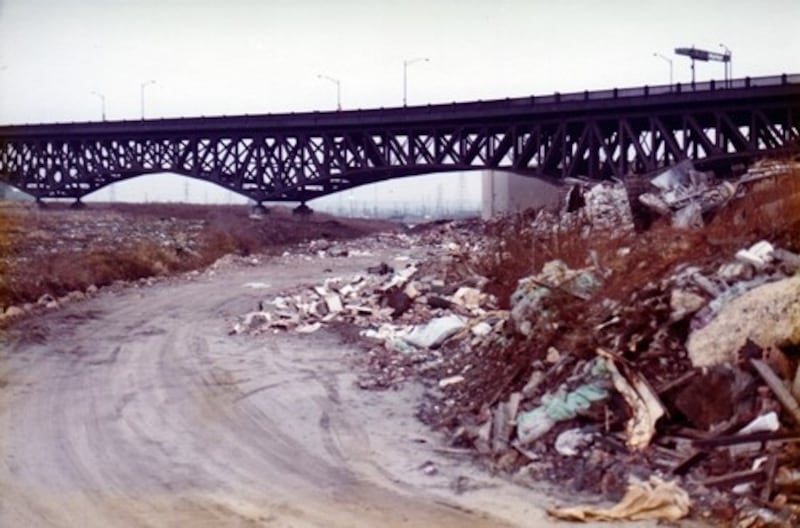
Brother Moscato’s dump in New Jersey. There were allegations and a lot of speculation that Hoffa was buried here.
Courtesy Vince WadeThe problem with that scenario is the enormous risk involved in moving a dead body by truck across four states. How many other people would have to be involved? What if the truck was in an accident? What if something went wrong at a truck weight station?
“We looked in to that,” Garrity said. Agents interviewed employees and examined the manifests for all of Gateway’s trucks. “We thought, ‘this is crazy.’ But if you don’t have a body, you go look.”
As Garrity wrote in the Hoffex memo: “…it is unknown why the body would be transported back to New Jersey when Detroit Organized Crime people have proven in the past they are capable of taking care of such things.” In the 1995 interview Garrity cited a fact well-known to professional killers. “The criminals are most vulnerable when they are with the victim, so they would have tried to do it somewhere close by,” Garrity said.
Dan Moldea, the author, is among those of us who believe the late Sal Briguglio, Provenzano’s close associate, is the guy who whacked Hoffa with the help of his brother Gabe and Thomas Andretta. Briguglio was murdered gangland-style in New York in March, 1978. He was about to go on trial with Provenzano for the Castellito murder. At the time he was killed there were street rumors Briguglio was considering a deal with the feds about Hoffa in exchange for help with the Castellito case. The New York police said it was a professional hit. Briguglio’s murder has never been solved.
Recently I asked Moldea why Sheeran would claim credit for killing Hoffa.
"For money," Moldea said. “[It was] a cynical attempt to grab money at the end of his life to leave to his family, as opposed to being dead broke. He confessed to a crime he didn’t commit.”
Moldea believes Hollywood’s fabricated facts in so-called true-story movies such as The Irishman probably don’t matter to most people and the public doesn’t really care who killed Jimmy Hoffa. "They just want to see a great movie and they’re going to get it. I’m sure they’re going to get it."
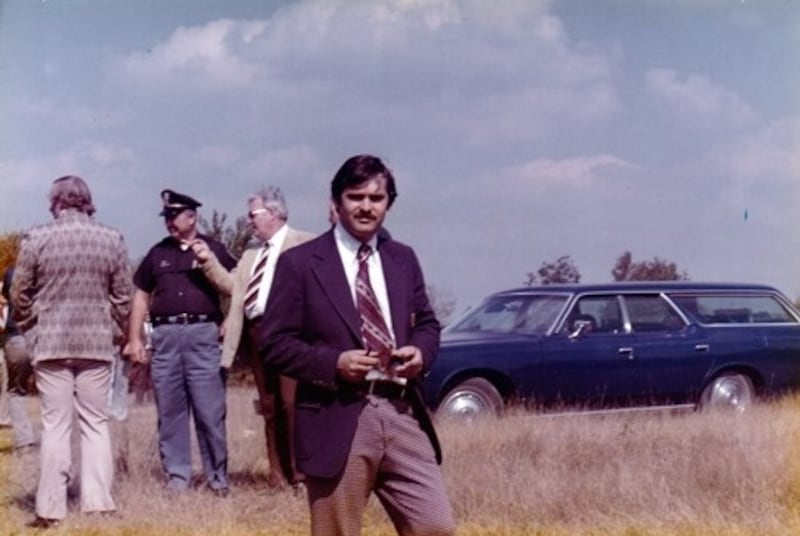
Vince Wade at the U.S. Senate Hoffa dig.
Courtesy Vince Wade